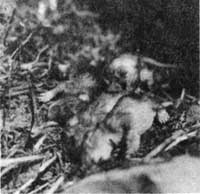|
Volume XVII - 1951
Pack Rats
By Philip Ross, Ranger-Naturalist

"The youngsters...had dainty pink noses and feet."
|
The naturalists had been annoyed by an unknown nightly visitor to
the Information Building during the month of July, that left disorder in
its wake. The flowers so carefully arranged for display were chewed off
and scattered in distant parts of the room. Traps in numbers were set
for the villain, but they were untouched during the night. Tidbits of
cheese, candy, peanut butter, even the flowers so avidly stolen from the
display table would not entice the pilferer to his capture.
The end was sudden; a female pack rat was discovered in the wood
pile on July 31 and was quickly dispatched. But this did not make an end
of the episode. The next morning, upon opening the building, we heard
hungry squeals coming from above. Upon investigation, the rat's nest was
found upstairs and within it four babies. The heterogeneous components
of the structure included four of the traps that had been set out, two
large signs used on the self-guiding nature trails, bits of rocks, paper
and wood. The interior was snugly lined with fur from the mother and
small pieces of newspaper.

"They were fed cream sweetened with syrup through a
medicine dropper to which they clung with eagerness."
|
The youngsters, only two or three days old, with pelage still
matted, had dainty pink noses and feet. The eyes had not yet opened, nor
did they open during the next three days of pampered but forced
residence at Park Headquarters. The young measured two inches in length
with naked tails about three-quarters of an inch long. They were fed
cream sweetened with syrup through a medicine dropper to which they
clung with eagerness. A small feeding was required at least every
half-hour, but my maternal efforts were insufficient to sustain the
delicate thread of life within them. After all, they had endured a long
day's hunger when mother had made her demise.
The flowers now remain undisturbed on the display table during the
night. No longer need the naturalists go afield each morning with
vasculum under arm in search of fresh blossoms to show park visitors.
The benefits of the nocturnal rearrangement and disposal have come to an
end, but another yarn has been added to the many involving this
character of prankish caprice.
Muskrat Record
By Dr. C. F. Yocom, Ranger-Naturalist
On August 8, 1951, I found an adult muskrat on the park highway four
miles north of the South Entrance. Apparently it had been hit by a car
as it was attempting to cross the road. As Annie Creek nearby has cut a
deep canyon with sheer walls, it seems quite unlikely that the animal
was making that creek its home. Muskrats are known to rove or migrate
considerable distances in the fall. Possibly this individual was in
search of a new home.

On a sparkling winter's day
| 
